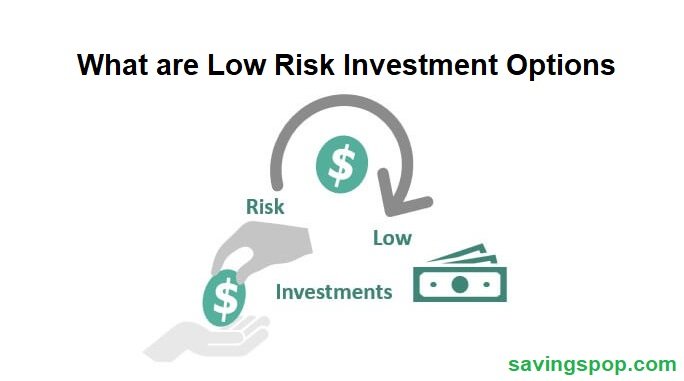Investing is an important part of financial planning, however, it often comes with dangers. Understanding and handling those dangers is important, especially for individuals who choose safety and stability. This article will delve into what are low risk investment options, supporting you’re making knowledgeable decisions that balance safety and returns.
What are Low Risk Investment Options
Investment chance refers to the possibility of dropping a few or all the unique investments. Various factors impact investment threats, including market volatility, financial conditions, and company performance. Balancing chance and praise is essential to a hit-making investment. High-risk investments may offer higher returns however come with increased capability for loss. Low-risk investments, alternatively, prioritize the maintenance of capital and provide steady, albeit decreased, returns.
Factors Influencing Investment Risk
Understanding the factors that influence investment threat assists you in making greater knowledgeable choices:
- Market Volatility: Sudden adjustments in market situations can notably affect the price of investments.
- Economic Conditions: Economic downturns or booms can affect funding overall performance.
- Interest Rates: Changes in interest quotes can impact the returns on sure investments, together with bonds.
- Company Performance: For shares and corporate bonds, the monetary fitness and overall performance of the issuing corporation are critical.
Importance of Low-Risk Investments
Low-risk investments are vital for several reasons:
- Preservation of Capital: These investments are aware of keeping your initial funding safe.
- Steady Income Generation: They provide normal and predictable returns, which is right for the ones needing reliable income.
- Suitability for Conservative Investors: Perfect for retirees or people with short-term monetary goals who can not have the funds for enormous losses.
Must Read: How to Diversify Investments For Retirement?
Types of Low-Risk Investments
Savings Accounts
They are a stable choice for saving money.
- Features: They offer easy access to funds and are insured by the government up to a certain limit.
- Interest Rates: Typically lower than other investment types but stable and risk-free.
- Pros: High liquidity, safety, and ease of use.
- Cons: Returns are low when compared to other investing possibilities.
Savings bills are suitable for emergency price ranges and brief-time period savings dreams. They offer peace of thoughts, knowing your money is stable and handy whilst wished.
Certificates of Deposit (CDs)
Banks offer time deposits known as certificates of deposit (CDs).
- How They Work: You deposit a set sum of money for a targeted duration at a predetermined hobby fee.
- Types: Traditional, jumbo, and no-penalty CDs.
- Pros: Higher hobby fees than financial savings bills, protection, and glued returns.
- Cons: Limited liquidity and consequences for early withdrawal.
CDs are best for the price ranges that you don’t need to immediately get the right of entry to and may lock away for a special term, from some months to several years. Longer-time period CDs usually offer better interest fees.
Money Market Accounts
They combine the benefits of saving and checking.
- Explanation: They offer higher interest rates than regular savings accounts and limited check-writing abilities.
- Comparison: Generally, they have higher minimum balance requirements than savings accounts.
- Pros: Better returns, liquidity, and check-writing capabilities.
- Cons: Higher minimum balance requirements and potential fees.
Money market money owed is appropriate for those who need to keep liquidity but want better returns than a well-known savings account. They are regularly used for larger emergency funds or quick-term funding dreams.
Treasury Securities
They are considered extremely safe.
- Overview: Includes Treasury bills, notes, and bonds.
- How They Work: The government borrows money from investors for a fixed period, paying back with interest.
- Pros: High safety, regular interest payments, and tax advantages.
- Cons: Lower returns and interest rate risk.
Treasury securities are subsidized using the full faith and credit of the U.S. Authorities, making them one of the safest funding alternatives. They are suitable for conservative buyers seeking stability and modest returns.
Corporate Bonds
They typically offer higher yields than government bonds.
- Explanation: Companies trouble bonds to elevate capital, promising to repay the essential together with the hobby.
- Types: Investment-grade (low-chance) and excessive-yield (better-risk) bonds.
- Pros: Higher returns than government bonds and normal income.
- Cons: Credit danger and hobby rate hazard.
Corporate bonds can provide appealing returns, specifically funding-grade bonds issued through financially stable companies. However, it’s vital to assess the credit score rating of the issuing business enterprise to gauge the threat concerned.
Municipal Bonds
Municipal bonds are issued by local governments & municipalities.
- What Are They: Debt securities used to finance public projects like schools, highways, and hospitals.
- Tax Advantages: Interest earned is often exempt from federal and sometimes state taxes.
- Pros: Tax benefits, safety, and steady income.
- Cons: Lower returns and potential for local government financial issues.
They are particularly attractive to investors in higher tax brackets. They provide a stable income stream and contribute to community development projects.
Fixed Annuities
Fixed annuities are insurance products offering guaranteed returns.
- Definition: You pay a lump sum or collection of payments, and the insurer offers regular payments returned.
- Types: Immediate and deferred constant annuities.
- Pros: Guaranteed income, tax-deferred increase, and main safety.
- Cons: Limited liquidity and ability fees for early withdrawal.
For steady retirement earnings, fixed annuities are ideal. They offer tax-deferred growth and safety in opposition to marketplace volatility.
Dividend-Paying Stocks
Dividend-paying stocks are shares of companies that distribute part of their profits to shareholders.
- Explanation: Companies pay dividends often, presenting a source of income.
- Why Low-Risk: Established groups with solid earnings often pay dividends.
- Examples: Large, well-known agencies with a record of regular dividend payments.
- Pros: Regular profits and capacity for capital appreciation.
- Cons: Market chance and dividend cuts all through economic downturns.
Shares that pay dividends can be a good choice for a low-risk investment. They offer both steady income and potential for growth. Focus on blue-chip companies with a tune record of steady dividends.
Preferred Stocks
Preferred stock is a type of equity that pays out fixed dividends.
- What Are They: Hybrid securities with characteristics of both stocks and bonds.
- Comparison: Higher claim on assets and earnings than common stocks but lower than bonds.
- Pros: Fixed dividends and priority over common stocks in case of liquidation.
- Cons: Limited capital appreciation and interest rate sensitivity.
Investors assume less risk with preferred stocks. They provide a stable income stream with less volatility.
Real Estate Investment Trusts (REITs)
Real Estate Investment Trusts (REITs) invest in income-producing real estate.
- Overview: Companies that personal, perform, or finance real estate.
- Types: Equity REITs, loan REITs, and hybrid REITs.
- Pros: Regular income, diversification, and capacity for capital appreciation.
- Cons: Market danger, hobby price threat, and control charges.
REITs offer exposure to real estate without the need to very own assets immediately. They are appropriate for traders searching for profits and diversification of their portfolios.
Comparison of Low-Risk Investments
Here’s a comparison of different low-risk investment options:
| Investment Type | Liquidity | Return | Risk Level | Tax Implications |
|---|---|---|---|---|
| Savings Accounts | High | Low | Very Low | Taxable |
| CDs | Low | Moderate | Very Low | Taxable |
| Money Market Accounts | High | Moderate | Very Low | Taxable |
| Treasury Securities | Moderate | Low | Very Low | Tax-Advantaged |
| Corporate Bonds | Moderate | Moderate | Low to Moderate | Taxable |
| Municipal Bonds | Low to Moderate | Low to Moderate | Very Low | Often Tax-Free |
| Fixed Annuities | Low | Low to Moderate | Very Low | Tax-Deferred |
| Dividend-Paying Stocks | High | Moderate | Low to Moderate | Taxable Dividends |
| Preferred Stocks | Moderate | Moderate | Low to Moderate | Taxable Dividends |
| REITs | High | Moderate | Low to Moderate | Taxable Dividends |
Strategies for Choosing Low-Risk Investments
Selecting the right low-risk investments requires careful consideration of several factors:
Assess Individual Risk Tolerance
Understanding your consolation stage with chance is critical. Low-chance investments are perfect for people who decide upon balance and can not find the money for sizeable losses.
Diversification
Diversification includes spreading your investments across specific asset instructions to minimize hazards. A nicely varied portfolio can guard in opposition to market volatility and reduce the effect of terrible performance in a single funding.
Investment Horizon
Consider your investment horizon, that is the time you’ve got until you need the cash. Low-danger investments are appropriate for quick to medium-time period desires, in which maintaining capital is extra essential than excessive returns.
Financial Goals
Align your investments along with your economic objectives. For example, in case you need a reliable income move for retirement, fixed annuities or dividend-paying stocks may be suitable.
Real-Life Examples and Case Studies
1: Conservative Retiree Portfolio
- Profile: A 65-year-old retiree looking for a steady income.
- Portfolio: 30% savings accounts, 20% Treasury securities, 20% municipal bonds, 20% dividend-paying stocks, 10% REITs.
- Outcome: The retiree enjoys a stable income with minimal risk, ensuring financial security in retirement.
2: Young Professional’s Emergency Fund
- Profile: A 30-year-old professional building an emergency fund.
- Portfolio: 50% savings accounts, 30% money market accounts, 20% short-term CDs.
- Outcome: The professional has quick access to funds in case of emergencies while earning moderate returns.
3: Balanced Investment Strategy
- Profile: A 45-year-old investor seeking a balance between growth and safety.
- Portfolio: 20% corporate bonds, 20% Treasury securities, 20% dividend-paying stocks, 20% fixed annuities, 20% REITs.
- Outcome: The investor enjoys steady income and growth potential while maintaining a low-risk profile.
Common Myths About Low-Risk Investments
Myth 1: Low-Risk Means No Risk
While low-risk investments prioritize safety, they are not entirely risk-free. Factors such as inflation, interest rate changes, and credit risk can still impact their performance.
Myth 2: Low Returns Are Not Worth It
Low-risk investments may offer lower returns, but they provide stability and capital preservation, which are crucial for specific financial goals, such as retirement planning.
Myth 3: Only for Older Investors
Low-risk investments are suitable for investors of all ages, especially those with short-term goals or low-risk tolerance. Building an emergency fund or saving for a down payment on a house are common scenarios where low-risk investments are beneficial.
Conclusion
Low-chance investments play a vital position in a properly-rounded investment strategy. They offer balance, protection of capital, and consistent income, making them suitable for conservative buyers or those with particular financial goals. By knowing the numerous low-risk options available and aligning them together with your risk tolerance and economic goals, you could build a stable and resilient portfolio.
Investing is not one-size-fits-all, and it’s essential to not forget your instances, dreams, and threat tolerance. Consult with a financial marketing consultant to create a tailor-made funding plan that meets your wishes and allows you to reap economic safety.




